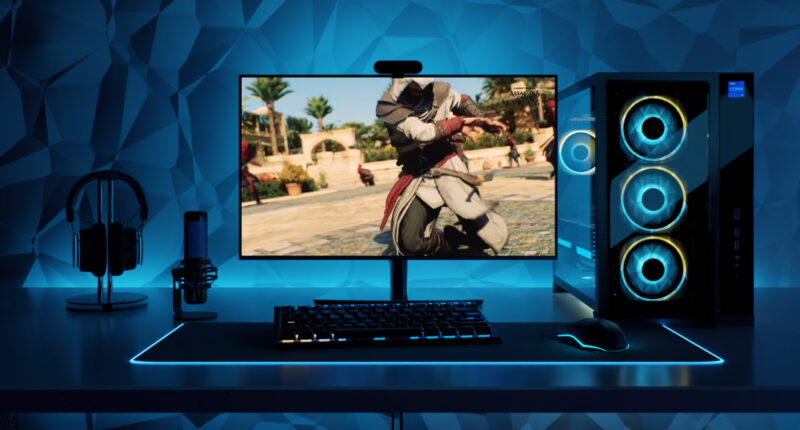Optimize You PC for Gaming
Gaming is a demanding task for any computer system, pushing the hardware and software to their limits. To ensure the best performance, you must optimize your PC, balancing power, efficiency, and stability. In this guide, we’ll explore various methods to maximize your PC’s gaming potential. From hardware upgrades to software tweaks, we cover it all in this comprehensive guide lets start it.
1. Upgrade Your Hardware
a. Graphics Card (GPU)
The GPU is the heart of any gaming PC. Upgrading to a more powerful graphics card can significantly enhance your gaming experience. Look for GPUs that offer a good balance between performance and price, and ensure your power supply can handle the new card’s power requirements.
Recommendation: NVIDIA GeForce RTX 3060 or AMD Radeon RX 6700 XT
b. Central Processing Unit (CPU)
A strong CPU ensures smooth gameplay, especially in CPU-intensive games. Consider upgrading to a newer, faster processor. Intel’s i5 and i7 series or AMD’s Ryzen 5 and Ryzen 7 series are excellent choices for gamers.
Recommendation: Intel Core i5-12600K or AMD Ryzen 5 5600X
c. Random Access Memory (RAM)
Modern games require substantial amounts of RAM. Upgrading to at least 16GB of RAM can help prevent slowdowns and stuttering. For future-proofing, 32GB is ideal.
Recommendation: Corsair Vengeance LPX 16GB (2 x 8GB) DDR4-3200
d. Solid State Drive (SSD)
Switching from a Hard Disk Drive (HDD) to an SSD can drastically reduce loading times and improve overall system responsiveness. Consider installing your operating system and games on an SSD for the best performance.
Recommendation: Samsung 970 EVO Plus 500GB NVMe SSD
e. Cooling System
Intense gaming generates heat. Invest in an efficient cooling system, such as additional case fans, liquid cooling, or a better CPU cooler, to prevent overheating and maintain performance.
Recommendation: Noctua NH-D15 air cooler or Corsair H100i RGB Platinum liquid cooler
2. Optimize Your Operating System
a. Update Your Operating System
Keeping your OS up-to-date ensures you have the latest performance improvements and security patches. Regular updates can also fix bugs that might affect game performance.
How to Update Windows:
- Press
Windows Key + Ito open Settings. - Go to
Update & Security. - Click
Check for updates.
b. Adjust Power Settings
Set your PC to “High Performance” mode in the power settings to ensure your hardware operates at its full potential during gaming sessions.
How to Set High Performance Mode:
- Press
Windows Key + Ito open Settings. - Go to
System>Power & sleep. - Click
Additional power settings. - Select
High performance.
c. Disable Unnecessary Startup Programs
Many programs start automatically when your PC boots up, consuming valuable resources. Use Task Manager to disable unnecessary startup programs.
How to Disable Startup Programs:
- Press
Ctrl + Shift + Escto open Task Manager. - Go to the
Startuptab. - Right-click unnecessary programs and select
Disable.
d. Keep Your System Clean
Regularly clean your PC’s internals and manage disk space. Use tools like Disk Cleanup to remove temporary files and free up space on your drives.
How to Use Disk Cleanup:
- Press
Windows Key + Sand typeDisk Cleanup. - Select the drive you want to clean and click
OK. - Check the boxes for the types of files you want to delete and click
OK.
3. Update Drivers
a. Graphics Drivers
Manufacturers like NVIDIA and AMD frequently release driver updates optimized for the latest games. Keeping your GPU drivers updated is crucial for peak performance.
How to Update NVIDIA Drivers:
- Open GeForce Experience.
- Go to the
Driverstab. - Click
Check for updatesand install any available updates.
How to Update AMD Drivers:
- Open AMD Radeon Software.
- Click the
Check for updatesbutton and follow the prompts to install the latest drivers.
b. Motherboard and Chipset Drivers
Ensure your motherboard’s BIOS and chipset drivers are current. These updates can enhance system stability and compatibility with new hardware.
How to Update Motherboard BIOS:
- Visit your motherboard manufacturer’s website.
- Download the latest BIOS version.
- Follow the manufacturer’s instructions to update the BIOS, which usually involves creating a bootable USB drive.
c. Peripheral Drivers
Update drivers for gaming peripherals, such as keyboards, mice, and controllers, to ensure optimal performance and compatibility with games.
How to Update Peripheral Drivers:
- Visit the manufacturer’s website.
- Download and install the latest drivers for your device.
4. Adjust In-Game Settings
a. Resolution and Graphics Settings
Find the right balance between visual quality and performance. Lowering the resolution and reducing graphics settings like shadows, textures, and anti-aliasing can boost FPS without significantly affecting gameplay.
Recommendation: Start with medium settings and adjust according to your system’s performance.
b. Enable V-Sync or G-Sync
These settings can help reduce screen tearing and stuttering by synchronizing the game’s frame rate with your monitor’s refresh rate.
How to Enable V-Sync:
- Go to your game’s graphics settings.
- Enable
V-Sync.
How to Enable G-Sync:
- Right-click on the desktop and select
NVIDIA Control Panel. - Go to
Display>Set up G-SYNC. - Enable
G-SYNCfor your monitor.
c. Use In-Game Performance Tools
Many games offer built-in performance tools to help you optimize settings. Use these tools to test and adjust your configuration for the best performance.
Example: In Fortnite, go to Settings > Video and use the Performance Mode (Beta).
5. Overclocking
a. CPU and GPU Overclocking
Overclocking can provide a significant performance boost. However, it requires caution. Use software like MSI Afterburner for GPUs and BIOS settings for CPUs to increase clock speeds gradually. Monitor temperatures closely to avoid overheating.
How to Overclock with MSI Afterburner:
- Install and open MSI Afterburner.
- Increase the core clock and memory clock sliders slightly.
- Click
Applyand test stability with a benchmarking tool like Heaven Benchmark.
b. RAM Overclocking
Enabling XMP (Extreme Memory Profile) in your BIOS can overclock your RAM, increasing its speed and improving game performance. Be sure your RAM is designed for overclocking to avoid stability issues.
How to Enable XMP:
- Restart your PC and enter BIOS by pressing
DeleteorF2during boot. - Go to the
XMPprofile setting (usually found in theAdvancedorOverclocktab). - Enable XMP and save changes.
6. Optimize Network for Online Gaming
a. Use a Wired Connection
A wired Ethernet connection offers more stable and faster internet speeds than Wi-Fi, reducing lag and packet loss during online gaming.
Recommendation: Use Cat6 or Cat7 Ethernet cables for best performance.
b. Upgrade Your Router
Invest in a high-quality gaming router with features like Quality of Service (QoS) settings to prioritize gaming traffic over other network activities.
Recommendation: ASUS RT-AX88U or Netgear Nighthawk Pro Gaming XR500
c. Reduce Network Interference
Ensure your router is placed in a central location, away from other electronic devices that might cause interference.
d. Optimize Game Servers
Select game servers closest to your location to minimize latency. Many games allow you to choose servers manually for a better online experience.
How to Select Servers:
- Go to the game’s network settings.
- Choose the server region closest to your location.
7. Use Game Boosters and Optimizers
a. Game Mode in Windows 10
Enable Game Mode in Windows 10 to allocate more system resources to your game, improving performance and reducing background activity.
How to Enable Game Mode:
- Press
Windows Key + Ito open Settings. - Go to
Gaming>Game Mode. - Toggle
Game ModetoOn.
b. Third-Party Game Boosters
Software like Razer Cortex can optimize system performance by freeing up RAM, prioritizing CPU usage, and stopping unnecessary background processes.
How to Use Razer Cortex:
- Download and install Razer Cortex.
- Open the application and go to the
Game Boostertab. - Click
Boost Nowbefore launching your game.
8. Regular Maintenance
a. Keep Your System Clean
Dust and debris can cause overheating and hardware failure. Regularly clean your PC’s interior with compressed air to maintain optimal cooling.
Recommendation: Clean your PC every 3-6 months.
b. Monitor System Health
Use tools like HWMonitor or NZXT CAM to keep an eye on temperatures, fan speeds, and voltages. Regular monitoring can help you detect and address potential issues before they affect performance.
How to Use HWMonitor:
- Download and install HWMonitor.
- Open the application to view real-time hardware statistics.
c. Backup Your Data
Regularly backup your game saves and important files. Use cloud storage or external drives to ensure you don’t lose progress due to system crashes or hardware failures.
Recommendation: Use external drives or cloud services like Google Drive or OneDrive for backups.
9. Tweak Windows Settings
a. Disable Visual Effects
Windows’ visual effects can consume resources. Disable unnecessary effects by adjusting the performance settings under System Properties.
How to Disable Visual Effects:
- Press
Windows Key + Sand typeSystem. - Click
Advanced system settings. - Under the
Performancesection, clickSettings. - Select
Adjust for best performance.
b. Adjust Paging File
Manually managing the paging file (virtual memory) can help improve performance. Set it to a fixed size based on your RAM to prevent system slowdowns.
How to Adjust Paging File:
- Press
Windows Key + Sand typePerformance. - Click
Adjust the appearance and performance of Windows. - Go to the
Advancedtab and clickChangeunderVirtual memory. - Uncheck
Automatically manage paging file size for all drives. - Set the Initial size and Maximum size to a value recommended by Windows or based on your RAM size (usually 1.5 to 3 times the amount of RAM).
c. Disable Background Services
Services running in the background can affect gaming performance. Use the Services app to disable unnecessary services, but be cautious not to disable essential system functions.
How to Disable Background Services:
- Press
Windows Key + R, typeservices.msc, and pressEnter. - Right-click on unnecessary services and select
Properties. - Set the
Startup typetoDisabledand clickOK.
10. Upgrade to the Latest DirectX Version
a. DirectX 12 and Beyond
Ensure your system is using the latest version of DirectX. DirectX 12 offers improved performance and support for the latest gaming technologies.
How to Check DirectX Version:
- Press
Windows Key + R, typedxdiag, and pressEnter. - Check the DirectX version under the
Systemtab.
b. Check Game Compatibility
Some older games might perform better with earlier DirectX versions. Use compatibility settings to run these games on the appropriate DirectX version.
How to Set Compatibility Mode:
- Right-click on the game’s executable file and select
Properties. - Go to the
Compatibilitytab. - Check
Run this program in compatibility mode forand select the appropriate Windows version.
Conclusion
Optimizing your PC for gaming involves a combination of hardware upgrades, software tweaks, and regular maintenance. By following the steps outlined in this guide, you can ensure your system runs at its best, providing a smoother and more enjoyable gaming experience. Whether you’re a casual gamer or a competitive player, these tips will help you get the most out of your gaming rig. Happy gaming!









